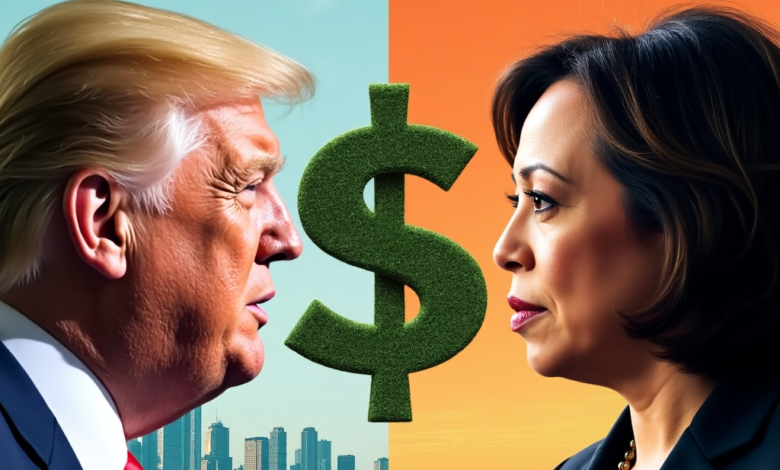
Harris and Trump’s Economic Plans: What Voters Need to Know
The 2024 presidential race between Kamala Harris and Donald Trump shows American voters two completely different visions for the US economy. Their economic proposals showcase opposite approaches to taxation, trade policies, and government spending. These differences will alter the economic map of America over the next several years.
Both candidates face major economic challenges in the United States that include climate change, AI adoption, and trade relationships with China and India. They propose different ways to handle economic growth, fund social programs, and reform tax policies. Let’s get into their main proposals and what they mean for various sectors of the economy.
Tax Policies: Cuts vs. Hikes
The tax policy stands at the heart of both candidates’ economic proposals, showing stark differences in their approaches to collecting revenue and distributing wealth. Harris wants to increase taxes for high-income earners and reduce them for lower-income households. Her plan aims to raise the corporate tax rate to 28% and boost capital gains tax to 28% for those earning above $1 million.
Harris’s proposals would lead to these economic effects:
- A 2.0% reduction in long-run GDP
- A 1.2% decrease in wages
- Changes affecting about 786,000 full-time equivalent jobs
Trump takes a different path by pushing to extend the 2017 Tax Cuts and Jobs Act with additional reductions. His proposal aims to lower the corporate tax rate to 15-20% for domestic production and make the 2017 individual income tax cuts permanent.
| Income Group | Harris Plan | Trump Plan |
|---|---|---|
| Bottom 20% | +7.0% income | -4.8% income |
| Middle 20% | +2.7% income | -2.1% income |
| Top 1% | -4.1% income | +1.2% income |
Economic analysis shows Trump’s plan would help the top 5% of earners most. Harris’s approach would raise taxes on the wealthiest 1% while giving tax relief to about 60% of Americans. The Congressional Budget Office suggests these contrasting strategies would create major changes in federal revenue and economic growth over the next decade.
Trade and Tariffs
Presidential candidates show stark differences in their trade policies that could reshape the US economy and international relations. Trump advocates an aggressive tariff strategy with a 10% universal tariff on all imported goods and a 60% tariff on Chinese imports.
These proposals would have the most important economic effects:
- The GDP would drop by 0.8%
- The economy would lose 684,000 full-time equivalent jobs
- Consumer prices could rise by 1.2% to 5.1%
Harris describes Trump’s tariff proposals as a “national sales tax” that might cost American families up to $4,000 each year. She supports targeted tariffs to protect strategic industries, and her strategy matches the current administration’s selective trade measures.
| Policy Component | Trump Proposal | Harris Approach |
|---|---|---|
| Universal Tariff | 10% on all imports | Targeted measures only |
| China-Specific | 60% on Chinese goods | Selective industry tariffs |
| Implementation | Immediate broad application | Strategic sector protection |
Economic analysts caution that extensive tariffs could prompt trading partners to retaliate. This would hit U.S. agricultural exports hard and reshape global supply chains. Yale Budget Lab’s research shows that Trump’s proposed tariffs, combined with potential retaliatory measures, could reduce annual household income by up to $7,600.
Social Programs and Credits
Both candidates have placed social programs and credits at the vanguard of their economic agendas, each taking different paths to support American families. Harris promotes a major expansion of existing benefits. She wants to increase the Child Tax Credit to $6,000 for newborns, $3,600 for children under six, and $3,000 for children aged 6-17. On top of that, her plan would boost the Earned Income Tax Credit to $1,500 for workers without children.
The benefits analysis shows clear differences between households:
- Low-income families would see an extra $2,750 yearly under Harris’s expanded credits
- Middle-income households would get about $1,430 under Trump’s plan
- The EITC expansion would give bottom-quintile households a $720 tax break
| Credit Type | Harris Proposal | Trump Plan |
|---|---|---|
| Child Tax Credit (Newborn) | $6,000 | $2,000 |
| Child Tax Credit (Under 6) | $3,600 | $2,000 |
| Child Tax Credit (6-17) | $3,000 | $2,000 |
Trump’s strategy keeps the Tax Cuts and Jobs Act’s $2,000 per-child credit and adds new exemptions for overtime pay, tips, and Social Security benefits. Economic analysts point out that upper-middle-class Americans would benefit most from these exemptions. Lower-income families often can’t take full advantage of these tax breaks because of existing exemptions and graduated rate structures.
Economic Growth Projections
Complete economic analyzes show both candidates’ proposals would affect the national debt and economic growth differently. The Committee for Responsible Federal Budget predicts Harris’s economic plan would add $3.95 trillion to the national debt by 2035. Trump’s proposals would add $7.75 trillion during the same period.
Economic indicators point to different outcomes:
- GDP growth potential: Harris’s policies could boost it by 0.2-0.4%
- Unemployment rate effect: 4.1% baseline prediction
- Inflation stabilization: 2.4% target stays
- Productivity growth: Positive trends continue
| Metric | Harris Plan | Trump Plan |
|---|---|---|
| Debt-to-GDP by 2035 | 134% | 143% |
| Deficit Impact | 8.1% of GDP | 9.5% of GDP |
| Revenue Generation | $4.3T | $3.7T |
Economic forecasts suggest Harris’s policies could keep current growth on track while controlling inflation through targeted measures. Trump’s proposals promise faster growth but face headwinds from possible tariff effects and higher deficit spending. Both candidates don’t deal very well with the predicted social security trust fund depletion, which could disrupt economic stability in the next decade.
The Wall Street Journal’s economist survey reveals 68% of experts think inflation would rise more under Trump’s policies. Only 12% believe inflation would be higher with Harris’s approach. These predictions consider how their trade, tax, and spending policies would affect the US economy.
Harris and Trump have proposed vastly different economic plans that show their unique visions for America’s financial future. Harris wants to raise taxes on wealthy individuals and corporations while boosting social programs. Her plan projects steady GDP growth and inflation control. Trump advocates widespread tax cuts and tough trade measures. His strategy promises faster economic growth, though it might lead to bigger deficits and market uncertainty from across-the-board tariffs. These opposing strategies would change how the government generates revenue, handles international trade, and funds social programs.
Voters must choose between two different economic directions that will affect household budgets, business operations, and the nation’s financial health. Economic experts suggest Harris’s approach could bring more stability but slower growth. Trump’s plan might speed up economic expansion but could increase deficits and create trade conflicts. These policies would affect Americans way beyond their time in office. The changes would influence everything from personal tax obligations to America’s standing in global markets over the next several years.







[…] power effectively to push forward their legislative agenda. Their influence extends from tax reform to immigration policy. The nation will likely see major changes in the way leaders handle and […]